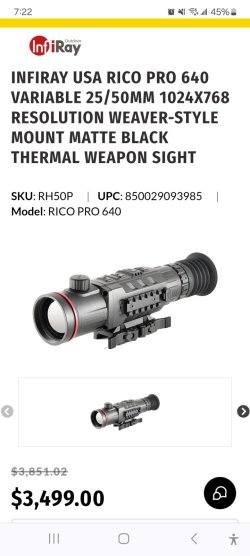Why would you stay away from a Thermion Pulsar? Cost is about the same . Thermion specs are better, especially resolution? The Thermion is a tank, ie built really well. It has a picture in picture feature where you can zoom in on one and stay at standard zoom with the other. My son-in-law uses it. Idk if I would.
Iray : MSRP $5,499.00
Thermion 2 LRF XP50: $5,499.97
Iray specs:
Thermion specs:
THERMION 2 LRF XL50
Our first thermal imaging riflescope with an HD resolution thermal sensor, the Pulsar Thermion 2 LRF XL50, offers the widest field of view, the most detailed image, and an extremely informative image even at high zoom.
Main specifications
Sensor 1024x768 @ 12 µm
Objective lens F50 / 1.0
Magnification, x 1.75 – 14
FOV (HxV), degrees 14 x 10.5
FOV (HxV), m@100m 24.6 х 18.5
Detection range 2300 m
Reticle
Click range, H/V, mm at 100m 4800 / 4800
Click value, H/V, mm at 100m 24 – 1.75х, 12 – 3.5х, 6 – 7х, 3 – 14х
Number of preloaded reticles 10
Sensor
Type uncooled
Resolution, pixels 1024x768
Pixel pitch, µm 12
Sensor NETD, mK < 35
Frame rate, Hz 50
Optics
Objective lens F50 / 1.0
Magnification, x 1.75 – 14
FOV (HxV), m@100m 24.6 х 18.5
FOV (HxV), degrees 14 x 10.5
Eye relief, mm 50
Display
Type
AMOLED HD
Resolution, pixels
1024x768
Laser rangefinder
Max. measuring range, m
800
Measurement accuracy, m
± 1
Safety class for laser equipment according to IEC 60825-1:2014
1
Wavelength, nm
905
Video recorder
Video / photo resolution, pixel 1024x768
Video / photo format .mp4 / .jpg
Build-in memory, GB 64
Bluetooth
Wireless protocol
BLE 4.2
Wireless standard
IEEE 802.15.1
Frequency, Ghz
2,4
WI-FI
Wireless protocol
Wi-Fi
Wireless standard
IEEE 802.11 b/g/n/ac (WPA)
Frequency, Ghz
2.4 / 5
Environmental characteristics
Degree of protectionIP code (IEC60529)
IPX7 (waterproof)
Operating temperature range, °С
-25 – +50
Connections and compatibilities
Compatible mounts
Standard 30 mm rings
Supported application
Stream Vision 2, Stream Vision Ballistics
Shock resistance on the smooth-bore rifles, caliber
12
Max. recoil power on rifled weapon (Eo), Joules
6000
Weight & size
Body material
Aluminum alloy
Dimensions, mm
426x78.5x94.5
Weight, kg
1,03
Iray : MSRP $5,499.00
Thermion 2 LRF XP50: $5,499.97
Iray specs:
| Device Technology: | Thermal Imaging |
| Objective Focal Length: | 50mm |
| Sensor Resolution: | 640×512 |
| Sensor Pixel Size: | 12μm |
| Detection Range: | 2400 Yards |
| Sensor Frame Rate: | 60hz |
| Optical Magnification: | 3X |
| Digital Magnification: | 4X, stepped |
Thermion specs:
THERMION 2 LRF XL50
Our first thermal imaging riflescope with an HD resolution thermal sensor, the Pulsar Thermion 2 LRF XL50, offers the widest field of view, the most detailed image, and an extremely informative image even at high zoom.
Main specifications
Sensor 1024x768 @ 12 µm
Objective lens F50 / 1.0
Magnification, x 1.75 – 14
FOV (HxV), degrees 14 x 10.5
FOV (HxV), m@100m 24.6 х 18.5
Detection range 2300 m
Reticle
Click range, H/V, mm at 100m 4800 / 4800
Click value, H/V, mm at 100m 24 – 1.75х, 12 – 3.5х, 6 – 7х, 3 – 14х
Number of preloaded reticles 10
Sensor
Type uncooled
Resolution, pixels 1024x768
Pixel pitch, µm 12
Sensor NETD, mK < 35
Frame rate, Hz 50
Optics
Objective lens F50 / 1.0
Magnification, x 1.75 – 14
FOV (HxV), m@100m 24.6 х 18.5
FOV (HxV), degrees 14 x 10.5
Eye relief, mm 50
Display
Type
AMOLED HD
Resolution, pixels
1024x768
Laser rangefinder
Max. measuring range, m
800
Measurement accuracy, m
± 1
Safety class for laser equipment according to IEC 60825-1:2014
1
Wavelength, nm
905
Video recorder
Video / photo resolution, pixel 1024x768
Video / photo format .mp4 / .jpg
Build-in memory, GB 64
Bluetooth
Wireless protocol
BLE 4.2
Wireless standard
IEEE 802.15.1
Frequency, Ghz
2,4
WI-FI
Wireless protocol
Wi-Fi
Wireless standard
IEEE 802.11 b/g/n/ac (WPA)
Frequency, Ghz
2.4 / 5
Environmental characteristics
Degree of protectionIP code (IEC60529)
IPX7 (waterproof)
Operating temperature range, °С
-25 – +50
Connections and compatibilities
Compatible mounts
Standard 30 mm rings
Supported application
Stream Vision 2, Stream Vision Ballistics
Shock resistance on the smooth-bore rifles, caliber
12
Max. recoil power on rifled weapon (Eo), Joules
6000
Weight & size
Body material
Aluminum alloy
Dimensions, mm
426x78.5x94.5
Weight, kg
1,03

